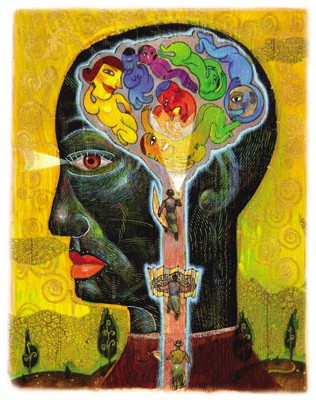Dreams have forever mystified humanity, offering a glimpse into the subconscious mind. Among the fascinating aspects of dreams is their ability to evoke a range of emotions. This article delves into the intricate relationship between our minds and emotions within the realm of dreams, unraveling the science that connects them.
The Dreaming Mind: A Complex Theater of Emotions
As the night falls and we drift into slumber, our minds embark on a remarkable journey. Dreams, the products of our sleeping minds, take us to worlds both familiar and strange. Dreams occur during different stages of sleep, primarily REM (Rapid Eye Movement) and non-REM sleep. It’s during these moments that the brain becomes a theatre for emotions to play out.
The Neurological Underpinnings of Emotional Dreams
The emotional landscapes of dreams are sculpted by the intricate workings of the brain. The limbic system, often referred to as the emotional center of the brain, plays a pivotal role. The amygdala, a part of the limbic system, is particularly noteworthy for its influence on emotional experiences in dreams. Neurotransmitters like serotonin and dopamine further contribute to the emotional content of dreams.
Unraveling the Emotional Palette of Dreams
Our dreams paint an emotional canvas that reflects the tapestry of our waking lives. They can encompass a spectrum of emotions—fear, joy, sadness, and more. Freud’s theories shed light on the symbolic nature of dreams, allowing us to decipher the emotional codes embedded within them. Cultural and individual differences also play a role in shaping dream emotions, making each dreamer’s experience unique.
The Emotional Continuity Hypothesis
Ever noticed how your dreams sometimes mirror the emotions you experience while awake? This phenomenon is known as the emotional continuity hypothesis. Research suggests that there’s a bridge between our waking and dreaming emotions. Our dreams, in a way, process the emotional residue of our daytime experiences, aiding in emotional memory consolidation during sleep.
Processing Emotions Through Dreams: Therapeutic Insights
The concept of using dreams for psychological healing dates back centuries. Dream analysis has evolved from Freud’s pioneering work to modern therapeutic approaches. Emotional dreams can serve as a platform for emotional regulation and resolution. Individuals grappling with emotional challenges find solace in exploring the depths of their dreams, uncovering insights that lead to healing.
The Science of Nightmares: Exploring Intense Negative Emotions in Dreams
Nightmares, the chilling specters of the dream world, offer a window into our subconscious fears and anxieties. These distressing dreams are more than just nocturnal terrors; they can be indicators of trauma and anxiety. For those with PTSD, nightmares can be haunting reminders. However, therapies and coping strategies offer ways to confront and alleviate the emotional distress they bring.
Cognitive Theories of Emotional Dreaming
Dreams, particularly emotional ones, have been speculated to serve evolutionary purposes. The threat simulation theory proposes that dreaming is a way for our minds to rehearse dealing with threats. Dreams can act as a form of emotional problem-solving, helping us navigate the challenges of waking life. These theories offer a cognitive perspective to complement the neurological explanations.
Lucid Dreaming: Navigating and Shaping Emotional Dreamscapes
Lucid dreaming adds a fascinating dimension to the world of dreams. In lucid dreams, dreamers are aware that they are dreaming and can even exert some control over the dream narrative. This presents a unique opportunity to navigate and manipulate emotional dreamscapes. Techniques for inducing lucid dreams open doors to confronting and resolving emotional issues within the dream realm.
Cross-Cultural Insights into Emotional Dreaming
Dreams and emotions aren’t confined by borders; they are influenced by cultural norms and beliefs. Cross-cultural studies have unveiled variations in dream themes and emotional experiences. Different societies attach diverse meanings to specific emotions within dreams. Comparing these cultural nuances provides a deeper understanding of the global landscape of emotional dreams.
Future Frontiers: Advancements in Studying Emotional Dreams
The intersection of science and technology offers exciting prospects for dream research. Innovations in brain imaging and neuroscientific techniques shed light on the mechanisms underlying emotional dreams. Interdisciplinary collaborations between psychology, neuroscience, and other fields pave the way for groundbreaking insights. As technology advances, we’re poised to uncover more about the enigmatic connection between the mind and emotions in dreams.
Conclusion
Emotional dreams continue to be an area of fascination and intrigue. They bridge the gap between our conscious and subconscious worlds, offering insights into our emotional landscapes. Understanding the science behind emotional dreams enhances our comprehension of human psychology and emotions. As we continue to explore the depths of our dreams, we unlock a richer understanding of the intricate bond between the mind and emotions.
FAQs
-
- What’s the relationship between dreams and emotions?
Dreams and emotions are intimately connected. Dreams often mirror the emotional experiences of our waking lives, allowing us to process and consolidate emotions during sleep.
-
- Can dreams really reflect our emotional state?
Yes, dreams can reflect our emotional state. The emotional continuity hypothesis suggests that there’s a link between our waking and dreaming emotions, helping us process and understand our feelings.
-
- How do nightmares relate to emotional trauma?
Nightmares can be linked to emotional trauma. They might replay distressing experiences or symbolize our fears and anxieties, offering insights into our emotional struggles.
-
- Are there cultural differences in the emotions depicted in dreams?
Absolutely, cultural norms and beliefs shape the emotional content of dreams. Different societies interpret and attach varying meanings to emotions within dreams.
-
- Can lucid dreaming be used as a therapeutic tool for emotional healing?
Yes, lucid dreaming can aid emotional healing. In lucid dreams, dreamers can confront and resolve emotional issues, making it a potential tool for therapeutic exploration.
-
- What’s the science behind dream interpretation?

Dream interpretation involves a combination of psychological theories and cultural contexts. Understanding the symbols and emotions in dreams can offer insights into our subconscious minds.
-
- How can I remember my dreams better to analyze their emotional content?
Keeping a dream journal by your bedside and jotting down your dreams as soon as you wake up can help improve dream recall and provide material for emotional analysis.
-
- Are there any ethical concerns about manipulating emotions through dreams?
Using techniques like lucid dreaming to manipulate emotions raises ethical questions. It’s essential to consider the potential impact and consequences of altering emotions within the dream realm.
-
- Do animals experience emotional dreams like humans?
There’s evidence to suggest that some animals may experience dream-like states. While we can’t directly know their emotional content, studies indicate similar brain activity patterns during REM sleep.
-
- What role do hormones play in influencing dream emotions?
Hormone her explanation s like serotonin and dopamine influence the emotional content of dreams. Imbalances in these hormones can impact the emotional tone of our dreams.

Welcome to my website! My name is Patrick Petherick, and I am a professional Emotional Dream Coach. I am passionate about helping individuals understand the profound symbolism and meaning behind their dreams, and guiding them towards emotional healing and personal growth. Check it





